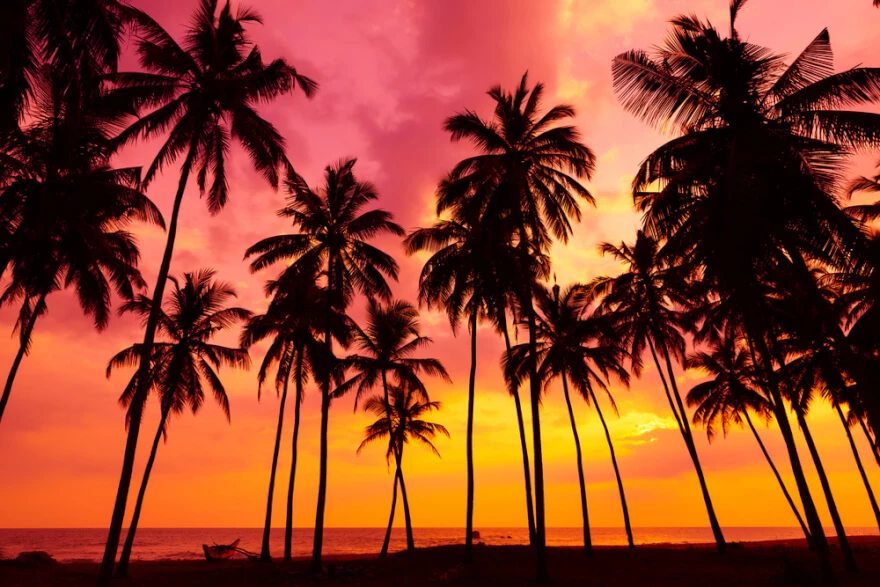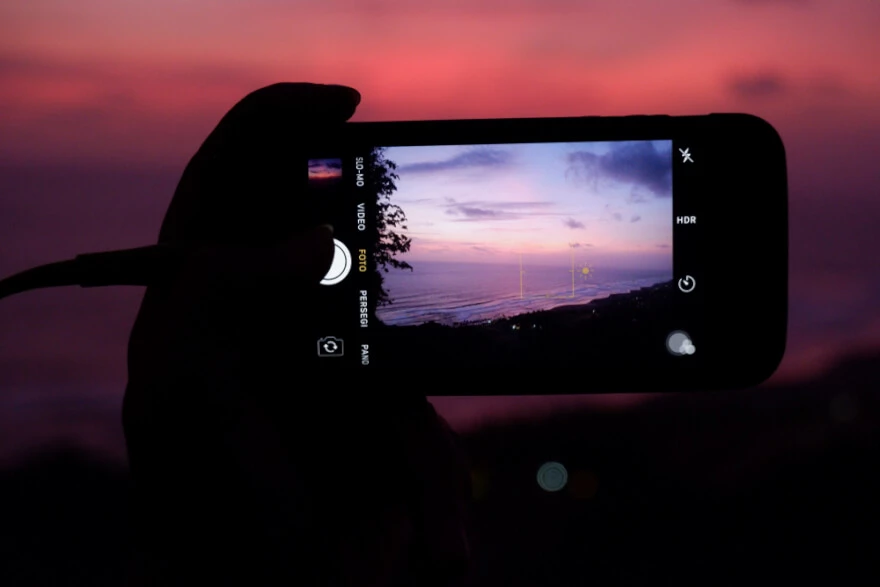Sunset photography

- 1. What is the right time for photography sunset?
- 2. How to use key shooting techniques?
- 3. Set the best camera for sunset photography
- 4. Collect sunset photography tips
- 5. Practice sunset silhouette photography
- 6. Create must-have photo equipment tutorial
- 7. Use a tripod for sunset couple photography
- 8. Shoot with a wide-angle lens sunset beach photography
Who doesn't like beautiful sunset photography? There is something bright and magic at this time of day that catches the attention of almost every person. But being attractive and ordinary, sunset can be just difficult to convey in pictures.
Equipment and camera settings are very important. However, being able to be in the right place at the right time of day is perhaps the most important factor for photographing the sunset. If you are visiting a new city and looking for a perfect place for sunset, it is best to do some online searches. In most cases, you will see sunset images taken from one or two popular places. It may take some time to find out exactly where these locations are, but as soon as you get an answer, you will find out where to go to shoot.

1. What is the right time for photography sunset?
A simple search will tell you when the sunset will occur at your chosen location. Keep in mind, however, that an hour or so before sunset is the ideal time of day for most photographers, so you need to appear at a chosen location at about a “golden hour”.

2. How to use key shooting techniques?
The difficulty is that sunset requires a good dynamic range for your camera. It is necessary to simultaneously work out both a bright sky and dark earth. Only DSLRs can boast to be appropriate for such hard work. But even a full-frame device (it is believed that its HDR is maximum) hardly achieves a simultaneous high-quality frame of both heaven and earth. A huge influence on the quality of photos has a lens. A critical parameter, in this case, is a lens flare. When the sun enters the frame inside an optical system, the number of light reflections from the lens surfaces increases significantly, due to which the picture loses contrast and “blooms” with sun rays.

3. Set the best camera for sunset photography
It is better to photograph in manual mode. There are several reasons. The most important thing is that each lens has a certain range of apertures for the best picture quality, as a rule, it is f / 5.6-f / 11. Landscapes (including sunset and sunrise) differ from portrait genres. It makes no sense to shoot at an open aperture - detail is low, depth of field will be small and not all objects will most likely fall into the depth of field area (although this may be an artistic design in some cases). Select shutter speed so that the long exposure level of a photo approximately matches what we see with our own eyes. Simply put, if the sky is bright in reality, it should also be bright in a photograph. In this case, an exposure meter can show overexposure to + 2EV. Make sure that area around the sun is not overexposed to whiteness and that solar disk on a picture is guessed. The solar disk, by the way, is almost guaranteed to be white - there is nothing wrong with that. An exception is a final stage of sunset when the disk has almost touched the ground, then it may turn out to be yellow or red.
It is most convenient to use an LCD digital display or an electronic viewfinder when shooting since it is possible to see the result before the shutter is released. For all its merits, the mirror viewfinder is less convenient when shooting the sunset. Be careful when capturing the sun with a telephoto lens. You can spoil your eyes if you look at the sun through a viewfinder for too long.
ISO sensitivity should be the smallest possible, but at the same time, ensuring the absence of "movement". Low sensitivity lengthens shutter speed, but provides a smoother color reproduction and reduces noise levels. Raising ISO sensitivity is only necessary if shooting with a telephoto lens without a stabilizer and a tripod - in this case, blurry images due to handshake increases.

4. Collect sunset photography tips
- Dimming is the most important tip when shooting sunsets and sunrises. A slightly underexposed shot will make colors more saturated and concentrated. The image will become more dramatic. You can darken pictures using manual mode or fast shutter speed. Taking pictures in aperture priority mode or using exposure compensation will help to make it deep and emotionally saturated.
- Find something in the foreground of a landscape. The best recipe for reproducing a good sunset is the presence of some objects in a foreground. It can be a pond, a mill, or some other building. Just find something interesting and include it in a composition. Similar action will add depth to the scene.
- Do not position the horizon line in the middle of a frame. A good general rule is to place the horizon in a lower third, if the colors of a sunset are especially beautiful and in upper third if the sunset is dull. Use bubble level on a tripod to make sure that your horizon is so straight that there is no straighter!

- Take a look around! Sometimes the landscape that is behind you can be magnificent, but it is easy to miss because photographers are usually too busy with the sunset. Do not forget to look over your shoulder so as not to miss what will look corny in daylight.
- Shoot in aperture priority mode with exposure compensation while the sun is still in the sky, and then switch to manual control of camera settings when the sun goes down. Aperture priority allows you to control the level of illumination, and in manual mode, you can then get a more accurate exposure. In poor light conditions, the built-in exposure meter often gives incorrect data.
- Do not be in a hurry. The sky usually again lights up with bright colors 25 minutes after the sun goes down over the horizon.
- Wait for suitable clouds. Ideal conditions for sunset landscape photography is variable cloud cover. Clouds in the sky will be highlighted by rays of setting sun and will serve as an amazing addition to the idea.

- Filters are prohibited! A polarizing filter will not help saturate colors. In addition, even UV filters must be removed when shooting. An additional flat, even ultra-thin piece of glass reduces saturation.
- Do not forget to remove your glasses. Even if those are with diopters, but sprayed to darken. Otherwise, it will seem to you that pictures are getting darker and darker, you will not be able to set exposure.
- Do not get carried away focusing on the clouds. In landscape photography, the focus point should be kept in one-third area of the bottom edge of a picture. This is approximate, but it’s worth adhering to the rule.
- Shoot in RAW. In sunset shades, there are so many delicate and transparent colors that can be lost if you shoot in JPEG. Squeeze maximum that your camera is capable of and get as much information as possible on the picture.
- Best sunsets can be caught in a viewfinder in the evening on a rainy day. As soon as clouds in the sky begin to disperse, you should grab your camera and run to the starting point, from which you can shoot.
- Make sure that you have an opportunity to use the flash if you plan sunset portrait photography. If you do not apply the flash, a face will be dark and muddy. If you are shooting a portrait, also pay attention to the fact that the horizon does not pass along the neck of a person. It will look much prettier if the horizon is at the abdomen or chest level of a model.

- If you want objects in rays of setting sun and luminary itself to be large, use a telephoto lens. Everything will become smaller, but it will be possible to capture a large area using a wide-angle lens.
- Consider different lighting conditions. When the sun begins to set but is still in the sky, the image on the LCD screen may look darker than it actually is. But the “second sunset”, which comes in 20-25 minutes, as the sun sets over the horizon, may give an impression that the image is brighter than it is. That is why it is better to trust histogram and not LCD. And do not delete images until you view them on a computer monitor.
- Before diving into beautiful sunset photography settings, make sure you have a clean lens. It should not have dust, stains, otherwise, you will have a problem during post-processing in editing apps. Variety of colors and shades in a sunset sky - the process of cleansing spots can drag on and nullify all previous efforts to create a professional masterpiece.
- Take a look at a fog feature. While you are trying to catch the essence of a sunset, the soft fog will add a dramatic effect to nature. Sunlight passing through cloudy fog also creates deep reds and violet shades that will help you create a strong scene for an exciting viewing experience. Learn to read the sky and try to predict what will happen.
- Be creative and have fun. Each person feels the need to connect with distant places in their memories. Think about how sunsets make you feel, and try to arouse this feeling in a viewer by establishing a connection through the photo.

5. Practice sunset silhouette photography
As with any shot, there should be a point of concentration in every sunset picture. And one of the best ways to add interest to any image is to include some silhouette in a frame. It can be something big, for example, an oak tree, or something that is part of the environment, as a fishing pier. You can also use a person for this adding black and white effects. Travel and look for intriguing places that include eye-catching shadows, backgrounds, and elements.
Silhouettes always determine the mood of an image while in the context of your ideas. Putting a silhouette outside the center of a frame is often a good idea to create additional intrigue.
Silhouettes in a beautiful way convey drama, anonymity, excitement, general mood to viewers of your photos and often stand out in an album. They create a strong plot through a contrast of simplicity. This style is in fashion among brides. They love them because they do not give the viewer a clear idea of everything, but leave room for imagination in wedding sunset photography.

6. Create must-have photo equipment tutorial
An important role in obtaining good shots is played by additional equipment. A tripod will allow you to avoid camera vibrations when shooting at a slow shutter speed that you will need at sunset time. Release cable will not allow it to move at the moment you press the button. The optimal solution for the shooting is a lens with a focal length of 50 mm and above. You can use wide-angle models, but in this case, the sun in a picture will be very small. Long-focus lenses will help you capture it in close-ups. Do not turn on the camera while the sun is still high. Starting work in advance is denied by all guides because you can harm your eyes and matrix of a device.

7. Use a tripod for sunset couple photography
You must have taken a lot of successful couple shots from your hands. However, there are several good reasons to get into a new habit of taking a tripod with you. It makes the shooting process slower and this is not always bad. When using a tripod, the emphasis is primarily on obtaining a competent love story composition. When the first goal is reached, you can focus on correct exposure. This can be very helpful when shooting in unusual lighting conditions of other people. After you take the picture, change the position. Try a different perspective. Raise or lower the camera. The result is more unique frames, rather than 50 shots that look almost the same. Add romantic vintage filters during post-processing in photoshop applications.
Another reason to get a tripod as the sun hides behind the horizon, illumination decreases. This means that you may need to set a very long shutter speed at which it is impossible to work with your hands. With a camera mounted on a tripod, you can take long exposure without fear of a shaking picture.

8. Shoot with a wide-angle lens sunset beach photography
When shooting the ocean and landscapes in general, photographers usually try to capture wide-open spaces. A focal length of 14mm to 24mm is a good starting point for taking a compiled shot that captures everything you need. Shooting with a wide-angle will also allow you to focus on sun glare, giving a more dramatic effect. After taking the picture, try adjusting the lens and using a zoom. Play with different focal lengths, isolating some areas. Try to capture the silhouette of a boat or other object in the background of a sun. The only limitation should be the imagination. There are no specific rules regarding focal length, so do not be afraid to experiment and enjoy the process.
Perhaps it turned out to be a little more complicated than one might initially think. But as soon as you find the time to prepare for magnificent sunsets and sunrises, you will get it. Indeed, the true value of photography lies in the appreciation and satisfaction of a moment. And each time, looking at your work, you will experience positive emotions, and mentally return at that time and to that place.
Co-founder of RetouchMe. In addition to business, he is passionate about travel photography and videography. His photos can be viewed on Instagram (over 1 million followers), and his films can be found on his YouTube channel.
Moreover, his profile is featured on the most popular and authoritative resource in the film industry — IMDb. He has received 51 international awards and 18 nominations at film festivals worldwide.

with RetouchMe














